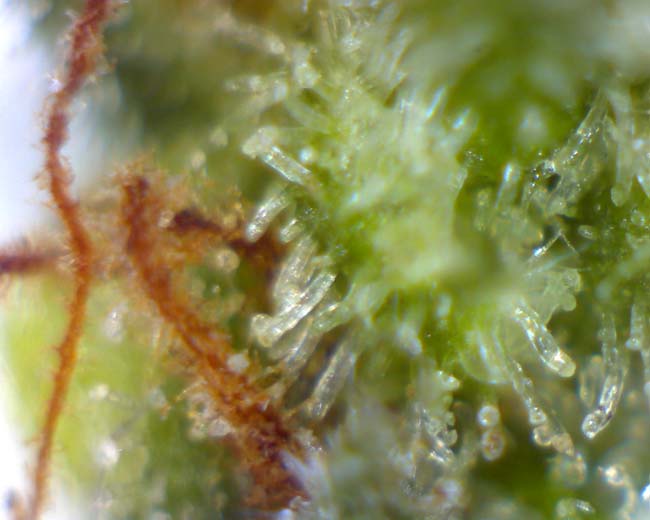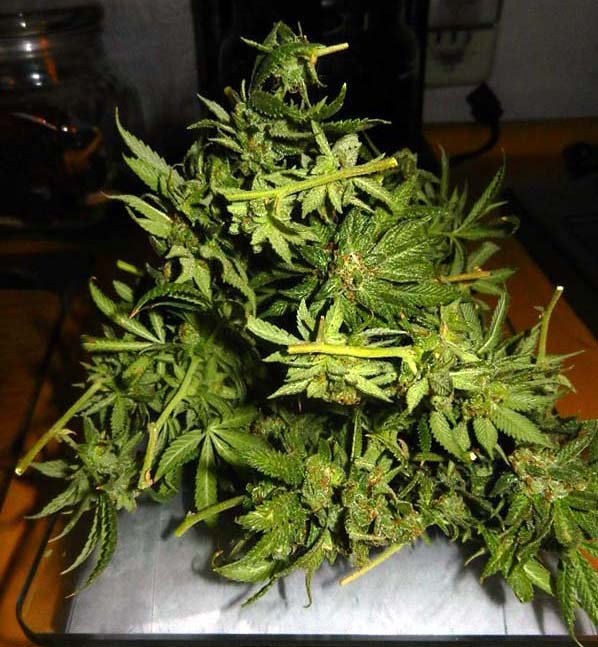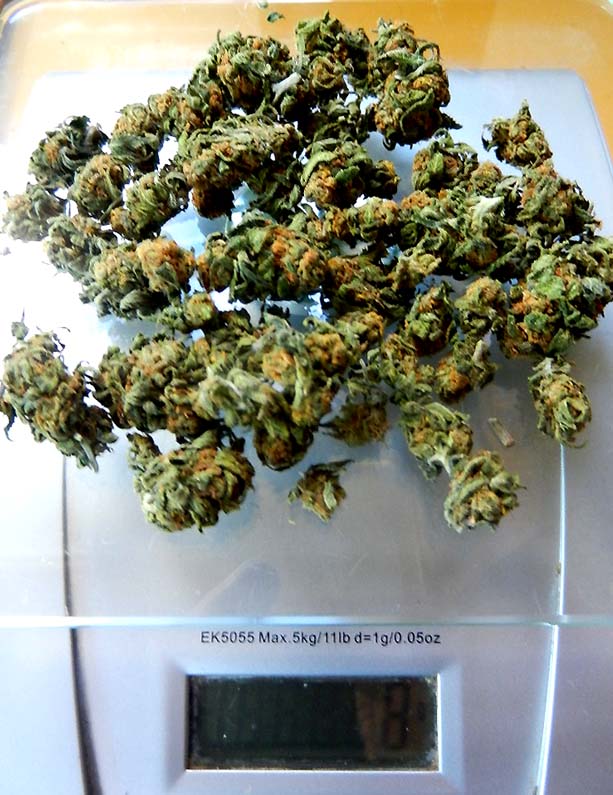Here is a enhanced (Photoshop) image emphasizing
the more exposed floral clusters resulting from the recent defoliation as seen from the
overhead light.
October 4th: Week 6 (Flowering)
Currently in the middle of a heat wave with outside temperatures in the
80's to 90's through the weekend. Shifted all plants to the vegetation chamber
and installed the A/C in the flowering chamber using the exhaust fan to vent
the extra heat. Since the two chambers are on opposite sides of a common hallway the doors between
them are left open during the day making, in effect, one contiguous chamber.
10:00 am: Inside grow room temps over 86 already and the A/C can no longer
could keep up. All plants moved to the front of the coach under the surround
windows and overhead fan which is just as acceptable and quite a bit more
energy efficient.
With another fan and the outside door open plus a little cross ventilation
the temps are 84F. This is their first exposure to direct
sunlight ... will have to get a good light meter to see if the lumination
equals that of the grow chambers.
Certainly there is enough light to carry
the plants through the next couple of days.
October 11th: Week 7 (Flowering)
I was wondering why the flowering chamber heated up so fast even
though the exhaust fan is 190 CFM (cubic feet per minute). Since the entire
chamber is only 24 cubic feet the air supply should be refreshed at least
7 times per minute.
Reread the instructions and realized the carbon filter had been installed
incorrectly. The filter is supposed to be in the chamber with the exhaust
fan mounted downstream pulling air through it and venting outside the chamber.
I had mounted both externally with the fan pushing the extracted air through
the filter instead. The extra load on the fan reduced its efficiency and
resulted in the heat build up.
Relocated the filter to the top of the flowering chamber in line with the
vent opening suspended by bailing wire from the ceiling.
Before the next grow I will attach a vent tube to the outlet side of
the external exhaust fan and route all the extracted heat out through
the roof so that will be removed from both the chamber and the coach.
For the time being it vents near the ceiling in the rear bedroom and is removed
by that room's 14" overhead fan.
October 18th: Week 8 (Flowering)
Added a 4" inline inlet fan to the flowering chamber to bring in cooler outside
air using a cut down gym sock over the inlet side duct to filter out insects,
dust and light.
This unit was inexpensive and doesn't produce a lot of air
movement ...40 CFM with a maxim boost of 80 CFM using an optional temperature
activated switch which was also ordered but hasn't arrived yet.
The fan
can be replaced by a more powerful fan if need be.
October 25th: Week 9 (Flowering)

Here are the trichomes at 58 days - fully developed and turning opaque with
resin. It would appear though they they will need another full week and perhaps
then some to become completely mature and ready for harvest.
These are some of the smallest flowers I've grown yet - only 2 or 3 are more
than 1.5 inches long and .75 inches in diameter. The majority of the buds
are under 1 inch by .5 inch in diameter. They are well formed and moderately
dense though with a pleasing odor.

Decided to harvest these flowers today due to the approaching rain with its
higher humidities and also because, in checking the trichomes, I discovered
what looked like a few spider mites in the foliage.
Rather than spraying, the flowers were removed from the plant and microwaved
for 60 seconds on high in the hopes of eliminating them. The flowers were then shaken over a paper plate and a second look under
the microscope confirmed that all the dislodged bugs (maybe 5-10) were dead. Hopefully that took care
of the problem but they will be observed over the next few days to make sure.
The total wet weight of the harvest was a disappointing 37 grams which should
produce only 10 grams or so of dried and cured flowers. The 60 seconds in
the microwave reduced that to 33 grams. The flowers will be dried over the
next 5-7 days in a brown paper bag with a Boveda humidity pack in order
to slow the process.
10-31: Down to 22 grams or 59% of the original wet weight. This size of this
initial drop is due to the time in the microwave yesterday which resulted
in a 4 gram reduction by itself. Otherwise it would have been only a drop
to 70% which is consistent with the other grows.
11-1: Down to 15 grams or 40% of the original weight wet.
November 2nd: Curing

Down to 10 grams or 27% by late afternoon. Did the final trim and realized
a full 8 grams or more than one quarter ounce. The buds were jarred with
a Boveda humidity pack to begin their cure. The pack will keep the RH in
the jar at the desired 62%.